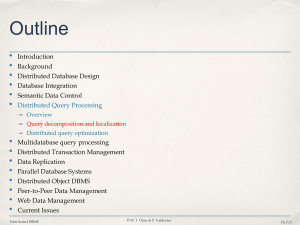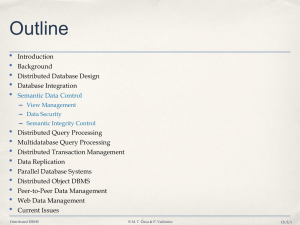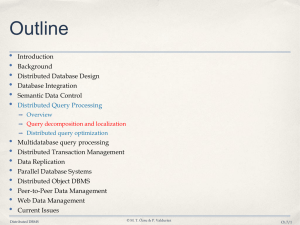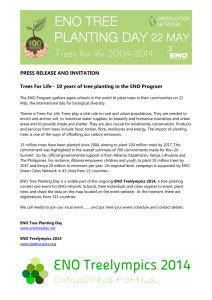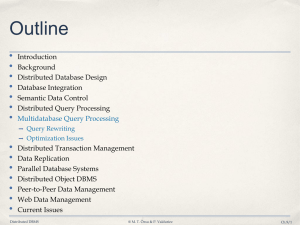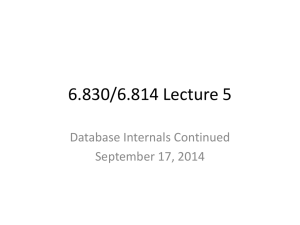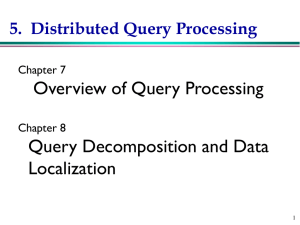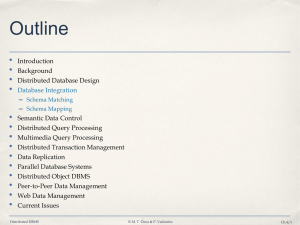Distributed Query Processing
advertisement
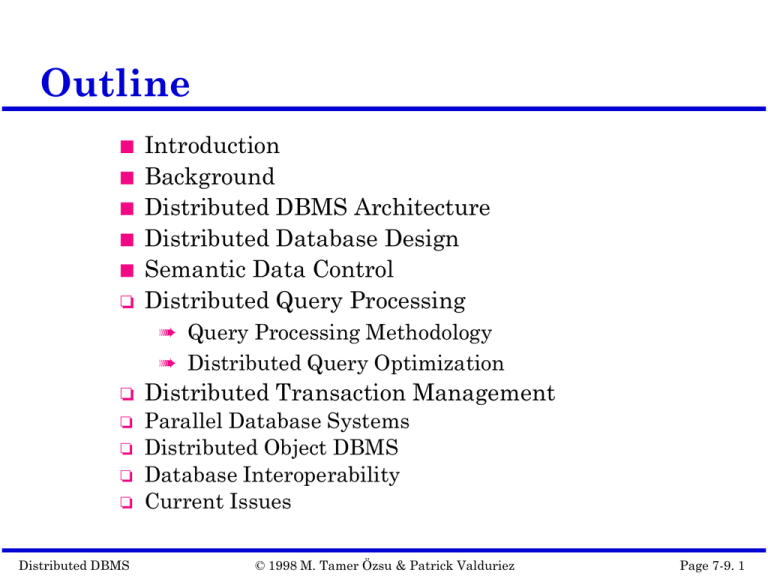
Outline
Introduction
Background
Distributed DBMS Architecture
Distributed Database Design
Semantic Data Control
Distributed Query Processing
Query Processing Methodology
Distributed Query Optimization
Distributed DBMS
Distributed Transaction Management
Parallel Database Systems
Distributed Object DBMS
Database Interoperability
Current Issues
© 1998 M. Tamer Özsu & Patrick Valduriez
Page 7-9. 1
Query Processing
high level user query
query
processor
low level data manipulation
commands
Distributed DBMS
© 1998 M. Tamer Özsu & Patrick Valduriez
Page 7-9. 2
Query Processing Components
Query language that is used
SQL: “intergalactic dataspeak”
Query execution methodology
The steps that one goes through in executing high-
level (declarative) user queries.
Query optimization
How do we determine the “best” execution plan?
Distributed DBMS
© 1998 M. Tamer Özsu & Patrick Valduriez
Page 7-9. 3
Selecting Alternatives
SELECT
FROM
WHERE
AND
ENAME
EMP,ASG
EMP.ENO = ASG.ENO
DUR > 37
Strategy 1
ENAME(DUR>37EMP.ENO=ASG.ENO (EMP ASG))
Strategy 2
ENAME(EMP
ENO
(DUR>37 (ASG)))
Strategy 2 avoids Cartesian product, so is “better”
Distributed DBMS
© 1998 M. Tamer Özsu & Patrick Valduriez
Page 7-9. 4
What is the Problem?
Site 1
Site 2
ASG1=ENO≤“E3”(ASG)
Site 3
ASG2=ENO>“E3”(ASG)
EMP1=ENO≤“E3”(EMP)
result = EMP1’EMP2’
EMP1’
Site 1
’
ENOASG1
ASG1’
ASG1’=DUR>37(ASG1)
Distributed DBMS
EMP2=ENO>“E3”(EMP)
Result
result2=(EMP1 EMP2) ENODUR>37(ASG1ASG1)
EMP2’
Site 4
EMP1’=EMP1
Site 5
Site 5
Site 5
Site 3
Site 4
EMP2’=EMP2
Site 2
’
ENOASG2
ASG1
ASG2
EMP1
EMP2
Site 1
Site 2
Site 3
Site 4
ASG2’
ASG2’=DUR>37(ASG2)
© 1998 M. Tamer Özsu & Patrick Valduriez
Page 7-9. 5
Cost of Alternatives
Assume:
size(EMP) = 400, size(ASG) = 1000
tuple access cost = 1 unit; tuple transfer cost = 10 units
Strategy 1
produce ASG': (10+10)tuple access cost
transfer ASG' to the sites of EMP: (10+10)tuple transfer cost
produce EMP': (10+10) tuple access cost2
transfer EMP' to result site: (10+10) tuple transfer cost
20
200
40
200
Total cost
460
Strategy 2
transfer EMP to site 5:400tuple transfer cost
transfer ASG to site 5 :1000tuple transfer cost
produce ASG':1000tuple access cost
join EMP and ASG':40020tuple access cost
4,000
10,000
1,000
8,000
Total cost
23,000
Distributed DBMS
© 1998 M. Tamer Özsu & Patrick Valduriez
Page 7-9. 6
Query Optimization Objectives
Minimize a cost function
I/O cost + CPU cost + communication cost
These might have different weights in different distributed
environments
Wide area networks
communication cost will dominate
low bandwidth
low speed
high protocol overhead
most algorithms ignore all other cost components
Local area networks
communication cost not that dominant
total cost function should be considered
Can also maximize throughput
Distributed DBMS
© 1998 M. Tamer Özsu & Patrick Valduriez
Page 7-9. 7
Complexity of Relational
Operations
Operation
Assume
relations of cardinality n
sequential scan
Complexity
Select
Project
(without duplicate elimination)
O(n)
Project
(with duplicate elimination)
Group
O(nlog n)
Join
Semi-join
O(nlog n)
Division
Set Operators
Cartesian Product
Distributed DBMS
© 1998 M. Tamer Özsu & Patrick Valduriez
O(n2)
Page 7-9. 8
Query Optimization Issues –
Types of Optimizers
Exhaustive search
cost-based
optimal
combinatorial complexity in the number of relations
Heuristics
not optimal
regroup common sub-expressions
perform selection, projection first
replace a join by a series of semijoins
reorder operations to reduce intermediate relation size
optimize individual operations
Distributed DBMS
© 1998 M. Tamer Özsu & Patrick Valduriez
Page 7-9. 9
Query Optimization Issues –
Optimization Granularity
Single query at a time
cannot use common intermediate results
Multiple queries at a time
efficient if many similar queries
decision space is much larger
Distributed DBMS
© 1998 M. Tamer Özsu & Patrick Valduriez
Page 7-9. 10
Query Optimization Issues –
Optimization Timing
Static
compilation optimize prior to the execution
difficult to estimate the size of the intermediate results
error propagation
can amortize over many executions
R*
Dynamic
run time optimization
exact information on the intermediate relation sizes
have to reoptimize for multiple executions
Distributed INGRES
Hybrid
compile using a static algorithm
if the error in estimate sizes > threshold, reoptimize at
run time
MERMAID
Distributed DBMS
© 1998 M. Tamer Özsu & Patrick Valduriez
Page 7-9. 11
Query Optimization Issues –
Statistics
Relation
cardinality
size of a tuple
fraction of tuples participating in a join with
another relation
Attribute
cardinality of domain
actual number of distinct values
Common assumptions
independence between different attribute values
uniform distribution of attribute values within their
domain
Distributed DBMS
© 1998 M. Tamer Özsu & Patrick Valduriez
Page 7-9. 12
Query Optimization Issues –
Decision Sites
Centralized
single site determines the “best” schedule
simple
need knowledge about the entire distributed
database
Distributed
cooperation among sites to determine the schedule
need only local information
cost of cooperation
Hybrid
one site determines the global schedule
each site optimizes the local subqueries
Distributed DBMS
© 1998 M. Tamer Özsu & Patrick Valduriez
Page 7-9. 13
Query Optimization Issues –
Network Topology
Wide area networks (WAN) – point-to-point
characteristics
low bandwidth
low speed
high protocol overhead
communication cost will dominate; ignore all other
cost factors
global schedule to minimize communication cost
local schedules according to centralized query
optimization
Local area networks (LAN)
Distributed DBMS
communication cost not that dominant
total cost function should be considered
broadcasting can be exploited (joins)
special algorithms exist for star networks
© 1998 M. Tamer Özsu & Patrick Valduriez
Page 7-9. 14
Distributed Query
Processing Methodology
Calculus Query on Distributed
Relations
Query
Decomposition
GLOBAL
SCHEMA
Algebraic Query on Distributed
Relations
CONTROL
SITE
Data
Localization
FRAGMENT
SCHEMA
Fragment Query
Global
Optimization
STATS ON
FRAGMENTS
Optimized Fragment Query
with Communication Operations
LOCAL
SITES
Local
Optimization
LOCAL
SCHEMAS
Optimized Local
Queries
Distributed DBMS
© 1998 M. Tamer Özsu & Patrick Valduriez
Page 7-9. 15
Step 1 – Query Decomposition
Input : Calculus query on global relations
Normalization
manipulate query quantifiers and qualification
Analysis
detect and reject “incorrect” queries
possible for only a subset of relational calculus
Simplification
eliminate redundant predicates
Restructuring
calculus query algebraic query
more than one translation is possible
use transformation rules
Distributed DBMS
© 1998 M. Tamer Özsu & Patrick Valduriez
Page 7-9. 16
Normalization
Lexical and syntactic analysis
check validity (similar to compilers)
check for attributes and relations
type checking on the qualification
Put into normal form
Conjunctive normal form
(p11p12…p1n) … (pm1pm2…pmn)
Disjunctive normal form
(p11p12 …p1n) … (pm1 pm2…pmn)
OR's mapped into union
AND's mapped into join or selection
Distributed DBMS
© 1998 M. Tamer Özsu & Patrick Valduriez
Page 7-9. 17
Analysis
Refute incorrect queries
Type incorrect
If any of its attribute or relation names are not defined in
the global schema
If operations are applied to attributes of the wrong type
Semantically incorrect
Components do not contribute in any way to the
generation of the result
Only a subset of relational calculus queries can be tested
for correctness
Those that do not contain disjunction and negation
To detect
Distributed DBMS
connection graph (query graph)
join graph
© 1998 M. Tamer Özsu & Patrick Valduriez
Page 7-9. 18
Analysis – Example
SELECT
FROM
WHERE
AND
AND
AND
AND
ENAME,RESP
EMP, ASG, PROJ
EMP.ENO = ASG.ENO
ASG.PNO = PROJ.PNO
PNAME = "CAD/CAM"
DUR ≥ 36
TITLE = "Programmer"
Query graph
Join graph
DUR≥36
ASG
ASG.PNO=PROJ.PNO
EMP.ENO=ASG.ENO
TITLE =
“Programmer”
EMP
ENAME
Distributed DBMS
RESP
RESULT
PROJ
EMP.ENO=ASG.ENO
EMP
ASG
ASG.PNO=PROJ.PNO
PROJ
PNAME=“CAD/CAM”
© 1998 M. Tamer Özsu & Patrick Valduriez
Page 7-9. 19
Analysis
If the query graph is not connected, the query is
wrong.
SELECT
FROM
WHERE
AND
AND
AND
ENAME,RESP
EMP, ASG, PROJ
EMP.ENO = ASG.ENO
PNAME = "CAD/CAM"
DUR ≥ 36
TITLE = "Programmer"
ASG
EMP
ENAME
Distributed DBMS
RESP
RESULT
PROJ
PNAME=“CAD/CAM”
© 1998 M. Tamer Özsu & Patrick Valduriez
Page 7-9. 20
Simplification
Why simplify?
Remember the example
How? Use transformation rules
elimination of redundancy
idempotency rules
p1 ¬( p1) false
p1 (p1 p2) p1
p1 false p1
…
application of transitivity
use of integrity rules
Distributed DBMS
© 1998 M. Tamer Özsu & Patrick Valduriez
Page 7-9. 21
Simplification – Example
SELECT
FROM
WHERE
OR
AND
OR
AND
TITLE
EMP
EMP.ENAME = “J. Doe”
(NOT(EMP.TITLE = “Programmer”)
(EMP.TITLE = “Programmer”
EMP.TITLE = “Elect. Eng.”)
NOT(EMP.TITLE = “Elect. Eng.”))
SELECT
FROM
WHERE
Distributed DBMS
TITLE
EMP
EMP.ENAME = “J. Doe”
© 1998 M. Tamer Özsu & Patrick Valduriez
Page 7-9. 22
Restructuring
Convert relational calculus to
relational algebra
Make use of query trees
Example
Find the names of employees other than
J. Doe who worked on the CAD/CAM
project for either 1 or 2 years.
SELECT ENAME
FROM
EMP, ASG, PROJ
WHERE
EMP.ENO = ASG.ENO
AND
ASG.PNO = PROJ.PNO
AND
ENAME ≠ “J. Doe”
AND
PNAME = “CAD/CAM”
AND
(DUR = 12 OR DUR = 24)
ENAME
Project
DUR=12 OR DUR=24
PNAME=“CAD/CAM”
Select
ENAME≠“J. DOE”
PNO
Join
ENO
PROJ
Distributed DBMS
ASG
© 1998 M. Tamer Özsu & Patrick Valduriez
EMP
Page 7-9. 23
Restructuring –
Transformation Rules
Commutativity of binary operations
RSSR
R
SS
R
RSSR
Associativity of binary operations
( R S ) T R (S T)
(R
S)
TR
(S
T)
Idempotence of unary operations
A’(A’(R)) A’(R)
p1(A1)(p2(A2)(R)) = p1(A1) p2(A2)(R)
where R[A] and A' A, A" A and A' A"
Commuting selection with projection
Distributed DBMS
© 1998 M. Tamer Özsu & Patrick Valduriez
Page 7-9. 24
Restructuring –
Transformation Rules
Commuting selection with binary operations
p(A)(R S) (p(A) (R)) S
p(Ai)(R
(Aj,Bk)
S) (p(Ai) (R))
(Aj,Bk)
S
p(Ai)(R T) p(Ai) (R) p(Ai) (T)
where Ai belongs to R and T
Commuting projection with binary operations
C(R S) A’(R) B’(S)
C(R
(Aj,Bk)
S) A’(R)
(Aj,Bk)
B’(S)
C(R S) C (R) C (S)
where R[A] and S[B]; C = A' B' where A' A, B' B
Distributed DBMS
© 1998 M. Tamer Özsu & Patrick Valduriez
Page 7-9. 25
Example
Recall the previous example:
Find the names of employees other
than J. Doe who worked on the
CAD/CAM project for either one or
two years.
SELECT
FROM
WHERE
AND
AND
AND
AND
ENAME
DUR=12 OR DUR=24
PNAME=“CAD/CAM”
ENAME
PROJ, ASG, EMP
ENAME≠“J. DOE”
ASG.ENO=EMP.ENO
ASG.PNO=PROJ.PNO
ENAME≠“J. Doe”
PNO
PROJ.PNAME=“CAD/CAM”
(DUR=12 OR DUR=24)
PROJ
Distributed DBMS
Project
ASG
© 1998 M. Tamer Özsu & Patrick Valduriez
Select
Join
ENO
EMP
Page 7-9. 26
Equivalent Query
ENAME
PNAME=“CAD/CAM” (DUR=12 DUR=24) ENAME≠“J. DOE”
PNO ENO
ASG
Distributed DBMS
PROJ
© 1998 M. Tamer Özsu & Patrick Valduriez
EMP
Page 7-9. 27
Restructuring
ENAME
PNO
PNO,ENAME
ENO
PNO
PNO,ENO
PNO,ENAME
PNAME = "CAD/CAM"
DUR =12 DUR=24
ENAME ≠ "J. Doe"
PROJ
ASG
EMP
Distributed DBMS
© 1998 M. Tamer Özsu & Patrick Valduriez
Page 7-9. 28
Step 2 – Data Localization
Input: Algebraic query on distributed relations
Determine which fragments are involved
Localization program
substitute for each global query its materialization
program
optimize
Distributed DBMS
© 1998 M. Tamer Özsu & Patrick Valduriez
Page 7-9. 29
Example
ENAME
Assume
EMP is fragmented into EMP1, EMP2,
EMP3 as follows:
EMP1=ENO≤“E3”(EMP)
EMP2= “E3”<ENO≤“E6”(EMP)
EMP3=ENO≥“E6”(EMP)
DUR=12 OR DUR=24
PNAME=“CAD/CAM”
ASG fragmented into ASG1 and ASG2 as
follows:
ASG1=ENO≤“E3”(ASG)
ASG2=ENO>“E3”(ASG)
ENAME≠“J. DOE”
PNO
ENO
Replace EMP by (EMP1EMP2EMP3 ) and
ASG by (ASG1 ASG2) in any query
PROJ
EMP1 EMP2 EMP3 ASG1
Distributed DBMS
© 1998 M. Tamer Özsu & Patrick Valduriez
ASG2
Page 7-9. 30
Provides Parallellism
ENO
EMP1
ENO
ASG1
Distributed DBMS
EMP2
ASG2
ENO
EMP3
ENO
ASG1
© 1998 M. Tamer Özsu & Patrick Valduriez
EMP3
ASG2
Page 7-9. 31
Eliminates Unnecessary Work
ENO
EMP1
Distributed DBMS
ENO
ASG1
EMP2
ENO
ASG2
EMP3
© 1998 M. Tamer Özsu & Patrick Valduriez
ASG2
Page 7-9. 32
Reduction for PHF
Reduction with selection
Relation R and FR={R1, R2, …, Rw} where Rj= p (R)
j
pi(Rj)= if x in R: ¬(pi(x) pj(x))
Example
SELECT *
FROM
EMP
WHERE ENO=“E5”
ENO=“E5”
ENO=“E5”
EMP1
Distributed DBMS
EMP2
EMP3
© 1998 M. Tamer Özsu & Patrick Valduriez
EMP2
Page 7-9. 33
Reduction for PHF
Reduction with join
Possible if fragmentation is done on join attribute
Distribute join over union
(R1 R2)
S (R1
S) (R2
S)
Given Ri = p (R) and Rj = p (R)
i
Ri
Distributed DBMS
j
Rj = if x in Ri, y in Rj: ¬(pi(x) pj(y))
© 1998 M. Tamer Özsu & Patrick Valduriez
Page 7-9. 34
Reduction for PHF
Reduction with join - Example
Assume EMP is fragmented as before and
ASG1: ENO ≤ "E3"(ASG)
ASG2: ENO > "E3"(ASG)
Consider the query
SELECT*
FROM EMP, ASG
WHERE EMP.ENO=ASG.ENO
ENO
EMP1
Distributed DBMS
EMP2
EMP3
ASG1
© 1998 M. Tamer Özsu & Patrick Valduriez
ASG2
Page 7-9. 35
Reduction for PHF
Reduction with join - Example
Distribute join over unions
Apply the reduction rule
ENO
EMP1
Distributed DBMS
ENO
ASG1
EMP2
ENO
ASG2
© 1998 M. Tamer Özsu & Patrick Valduriez
EMP3
ASG2
Page 7-9. 36
Reduction for VF
Find useless (not empty) intermediate relations
Relation R defined over attributes A = {A1, ..., An} vertically
fragmented as Ri = A' (R) where A' A:
D,K(Ri) is useless if the set of projection attributes D is not in A'
Example: EMP1= ENO,ENAME (EMP); EMP2= ENO,TITLE (EMP)
SELECT ENAME
FROM
EMP
ENAME
ENAME
ENO
EMP1
Distributed DBMS
EMP2
© 1998 M. Tamer Özsu & Patrick Valduriez
EMP1
Page 7-9. 37
Reduction for DHF
Rule :
Distribute joins over unions
Apply the join reduction for horizontal fragmentation
Example
ASG1: ASG ENO EMP1
ASG2: ASG ENO EMP2
EMP1: TITLE=“Programmer” (EMP)
EMP2: TITLE=“Programmer” (EMP)
Query
SELECT
FROM
WHERE
AND
Distributed DBMS
*
EMP, ASG
ASG.ENO = EMP.ENO
EMP.TITLE = “Mech. Eng.”
© 1998 M. Tamer Özsu & Patrick Valduriez
Page 7-9. 38
Reduction for DHF
Generic query
ENO
TITLE=“Mech. Eng.”
ASG1
ASG2
Selections first
Distributed DBMS
EMP2
ENO
TITLE=“Mech. Eng.”
ASG1
EMP1
ASG2
© 1998 M. Tamer Özsu & Patrick Valduriez
EMP2
Page 7-9. 39
Reduction for DHF
Joins over unions
ENO
ENO
TITLE=“Mech. Eng.”
ASG1
EMP2
TITLE=“Mech. Eng.”
ASG2
EMP2
Elimination of the empty intermediate relations
(left sub-tree)
ENO
TITLE=“Mech. Eng.”
ASG2
Distributed DBMS
EMP2
© 1998 M. Tamer Özsu & Patrick Valduriez
Page 7-9. 40
Reduction for HF
Combine the rules already specified:
Remove empty relations generated by contradicting
selections on horizontal fragments;
Remove useless relations generated by projections
on vertical fragments;
Distribute joins over unions in order to isolate and
remove useless joins.
Distributed DBMS
© 1998 M. Tamer Özsu & Patrick Valduriez
Page 7-9. 41
Reduction for HF
Example
Consider the following hybrid
fragmentation:
EMP1=ENO≤"E4" (ENO,ENAME (EMP))
EMP2=ENO>"E4" (ENO,ENAME (EMP))
ENAME
ENAME
ENO=“E5”
EMP3= ENO,TITLE (EMP)
ENO
and the query
SELECT
FROM
WHERE
ENO=“E5”
ENAME
EMP
ENO=“E5”
EMP2
EMP1 EMP2 EMP3
Distributed DBMS
© 1998 M. Tamer Özsu & Patrick Valduriez
Page 7-9. 42
Step 3 – Global Query Optimization
Input: Fragment query
Find the best (not necessarily optimal) global
schedule
Minimize a cost function
Distributed join processing
Bushy vs. linear trees
Which relation to ship where?
Ship-whole vs ship-as-needed
Decide on the use of semijoins
Semijoin saves on communication at the expense of
more local processing.
Join methods
nested loop vs ordered joins (merge join or hash join)
Distributed DBMS
© 1998 M. Tamer Özsu & Patrick Valduriez
Page 7-9. 43
Cost-Based Optimization
Solution space
The set of equivalent algebra expressions (query trees).
Cost function (in terms of time)
I/O cost + CPU cost + communication cost
These might have different weights in different distributed
environments (LAN vs WAN).
Can also maximize throughput
Search algorithm
How do we move inside the solution space?
Exhaustive search, heuristic algorithms (iterative
improvement, simulated annealing, genetic,…)
Distributed DBMS
© 1998 M. Tamer Özsu & Patrick Valduriez
Page 7-9. 44
Distributed Query Optimization
Problems
Cost model
multiple query optimization
heuristics to cut down on alternatives
Larger set of queries
optimization only on select-project-join queries
also need to handle complex queries (e.g., unions,
disjunctions, aggregations and sorting)
Optimization cost vs execution cost tradeoff
heuristics to cut down on alternatives
controllable search strategies
Optimization/reoptimization interval
extent of changes in database profile before
reoptimization is necessary
Distributed DBMS
© 1998 M. Tamer Özsu & Patrick Valduriez
Page 7-9. 45
